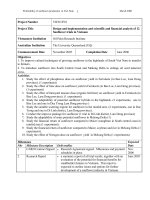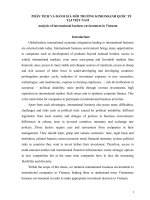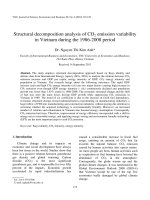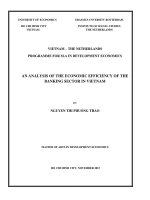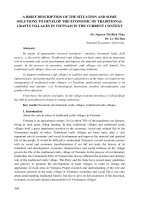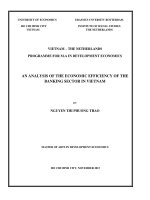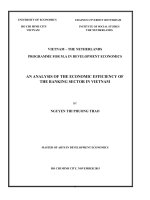TOPIC ANALYSIS OF THE CURRENT SITUATION OF THE DIGITAL ECONOMY IN VIETNAM
Bạn đang xem bản rút gọn của tài liệu. Xem và tải ngay bản đầy đủ của tài liệu tại đây (466.68 KB, 29 trang )
FOREIGN TRADE UNIVERSITY
FACULTY OF INTERNATIONAL ECONOMICS
---------***--------
MID-TERM INTERNATIONAL
ECONOMICS REPORT
TOPIC: ANALYSIS OF THE CURRENT SITUATION OF
THE DIGITAL ECONOMY IN VIETNAM
GROUP:
17
CLASS:
KTEE308.2
MEMBER: Dang Thai Son – 2013150046
Vu Tien Dat – 2012150020
Pham Le Huy - 2012150040
Hanoi, December 7th 2021
download by :
Numbe
r
59
14
26
2
download by :
ABSTRACT............................................................................................................................................... 4
DISCUSSION OF FINDINGS................................................................................................................. 5
CHAPTER 1: VIETNAM TODAY AND THE DIGITAL ECONOMY.......................................... 5
1.
2.
3.
Digital economy – a new development trend.......................................................................... 5
1.1.
What is the digital economy?.............................................................................................. 5
1.2.
Digital economy of the world.............................................................................................. 5
Advantages of developing the digital economy in Vietnam........................................................ 6
2.1.
Vietnam in relation to the global economy.......................................................................... 7
2.2.
Policies to support the digital economy in Vietnam............................................................ 8
2.3.
A promising start for the digital economy in Vietnam......................................................... 8
Challenges of developing the digital economy in Vietnam....................................................... 10
CHAPTER 2: THE CURRENT SITUATION OF THE DIGITAL ECONOMY IN VIETNAM
................................................................................................................................................................ 11
Digital transformation trend in Vietnam................................................................................ 11
1.
2.
1.1.
Foundation of digital transformation.................................................................................. 11
1.2.
ICT – the foundation for the booming digital economy in Vietnam.................................. 12
1.3.
Ecommerce......................................................................................................................... 14
1.4.
Smart logistics.................................................................................................................... 15
1.5.
Smart tourism..................................................................................................................... 16
1.6.
Smart health........................................................................................................................ 17
1.7.
Sharing economy................................................................................................................ 18
1.8.
Financial Technologies....................................................................................................... 19
The digital economy in Vietnam during the Covid-19 Pandemic.......................................... 20
CHAPTER 3: SOLUTIONS TO THE DIGITAL ECONOMY IN VIETNAM............................ 22
CONCLUSION....................................................................................................................................... 25
REFERENCES....................................................................................................................................... 26
ABSTRACT
Currently, the world economy is changing profoundly under the impact of the fourth
industrial revolution. Economic activity is not only just the mere exchange of goods but
3
download by :
is now based on a digital platform, which is the digital economy (also known as the web
economy, internet economy or new economy). According to researchers, the digital
economy is "an economy that operates mainly based on digital technology", especially
electronic transactions conducted through the Internet.
Over the past 10 years, Vietnam's digital economy has rapidly developed both in
terms of infrastructure and business market. With a population of nearly 100 million
people, Vietnam is considered as one of the countries with a good digital economy
development rate in the ASEAN region. Vietnam has recorded the emergence of
digitization trends in many fields and economic sectors, from commerce and payment to
transportation, education, health... According to the "Digital Economy of Southeast Asia
in 2019" report announced by Google, Temasek and Bain on October 3, 2019, Vietnam's
digital economy in 2019 is worth 12 billion USD (contributing 5% of GDP in 2019), 4
times higher than the price value in 2015 and is expected to reach 43 billion USD by
2025.
However, the level of active participation in the development of the digital economy
in our country is still limited and somewhat spontaneous. Currently, the system of
institutions, policies, as well as enforcement, dispute settlement and enforcement
agencies related to digital economy development is still weak, inconsistent and effective.
Our team has decided to conduct the study report “Analysis of the current situation of
the digital economy in Vietnam” to further research the advantages, challenges Vietnam
has and the current situation of the digital economy in Vietnam.
DISCUSSION OF FINDINGS
CHAPTER 1: VIETNAM TODAY AND THE DIGITAL ECONOMY
1. Digital economy – a new development trend
During the past four decades, Vietnam has undergone industrialization, modernization
and international integration. For this country, science, technology and innovation play an
important role in development: improving production capacity and competitiveness in
4
download by :
product value chains, revolutionizing business models and attract more investment
sources in the field of information and communication technology (ICT).
1.1. What is the digital economy?
According to the Oxford Digital Economy Collaboration, the digital economy is
understood as an economy that operates mainly on digital technology, especially
electronic transactions conducted through the Internet. Digital economy includes all
sectors and economies (industry, agriculture, services; production, distribution,
circulation of goods, transportation, logistics, finance and banking, ...) that in which
digital technology is applied.
In essence, we can see that these are organizational models and operating methods of
the economy based on the application of digital technology. We can easily see every day
the manifestations of digital technology appearing anywhere in life such as e-commerce
sites, online advertising or applications for food, transportation, and delivery. ... also
integrates digital technology to meet the convenience needs of customers. But if
considered at a more macro level, the digital economy also has significant contributions
to the integration of Vietnamese enterprises into the global technology chain and creates
great economic values to develop the country.
1.2. Digital economy of the world
In fact, we can see that the digital economy has brought many advantages to large
global companies and corporations. Specifically, large global enterprises are more or less
related to digital platforms and the digital economy (Google, Apple, Amazon, Microsoft
or Alibaba). The most prominent advantages of the strengths that the digital economy
brings can be mentioned: e-commerce growth; promote users to use the internet and
develop a system of digital economic goods and services. In addition to these advantages,
economic development in the direction of the digital economy also ensures transparency.
It should be understood that transparency is one of the strengths of the digital economy
that many countries around the world pay special attention to, thereby, indirectly reducing
5
download by :
the amount of money corruption through transparent online activities, giving
governments a better control of the economy.
2. Advantages of developing the digital economy in Vietnam
For Vietnam, the digital economy has made significant contributions to the integration
of businesses into the global technology chain. In the digital economy, businesses are
forced to innovate their traditional production and business processes into an ecosystem
model, linking from production, trade to use, and this will increase productivity. as well as
labor efficiency. The information and communication technology (ICT) platform is
considered as the core of digital transformation and is considered the most important part
of the Core Digital Economy. A healthy development of this platform will contribute to
helping Vietnam overcome the middle-income trap and move forward to rapid and
sustainable development.
Vietnam is considered a country with a good digital economy development rate in the
ASEAN region thanks to good telecommunications and information technology
infrastructure, wide coverage, and high user density. By the end of 2020, all three major
domestic mobile phone carriers, Viettel, VNPT and Mobifone have simultaneously
announced coverage areas and officially tested 5G service business, bringing Vietnam
into the group of countries being the first in the world to access this technology,
contributing to strongly promoting the digital economy. More importantly, unlike
previous technologies, which were mostly imported, Vietnam has gradually mastered and
manufactured 5G devices, a step of strategic significance in the development of
telecommunications technology.
2.1. Vietnam in relation to the global economy
Over the past 10 years, Vietnam's digital economy has rapidly developed both in
terms of infrastructure and business market. With a population of nearly 100 million
people, Vietnam is considered as one of the countries with a good digital economy
development rate in the ASEAN region. Vietnam has recorded the emergence of
6
download by :
digitalization trends in many fields and economic sectors, from commerce and payment
to transportation, education, health... According to the report "Digital Economy of
Southeast Asia" Asia in 2019" announced by Google, Temasek and Bain on October 3,
2019, Vietnam's digital economy in 2019 is worth 12 billion USD (contributing 5% of
GDP in 2019), 4 times higher than the price value in 2015 and is expected to reach 43
billion USD by 2025.
In terms of a number of criteria related to the digital economy, Vietnam is leading in a
number of areas:
• 5G network –Vietnam is one of the first countries in the world to test a 5G network,
which is expected to start rolling out in 2021.
•
High-achieving high school students – On international rankings for science,
reading and math subjects, Vietnamese students are on par or even higher than highincome countries
•
Moderate Internet service charges – Fixed broadband internet service charges in
Vietnam are among the lowest in the Asia Pacific region (converted according to
purchasing power parity).
This represents a comparison of capabilities in business and innovation, human
resource development, digital infrastructure and digital economy between Vietnam and
regional countries such as Indonesia. sia, Thailand and the Philippines. Accordingly,
Vietnam's areas of strength include the urgent export of high-tech products and the results
of the Global Innovation Index.
2.2. Policies to support the digital economy in Vietnam
The Government of Vietnam recognizes that the economy-wide digital transformation
is crucial to growth and prosperity. At this time, there are many agencies that
simultaneously support and regulate different parts of the digital economy in Vietnam.
The current legal framework is a compilation of trade regulations and decrees issued by
various ministries. For telecommunications and ICT matters, the Ministry of Information
and Communications is the main focal point.
7
download by :
In order to strongly promote the digital economy, besides the political will and
determination of the government, there should be a unified body or ministry that can
promote, regulate and carry out all activities. related to digital economic development.
This body can officially recognize the existence of the digital economy in the overall
economy and create consistency, synchronization and feasibility in the revision,
formulation and implementation of policies, programs and plans for the digital economy.
Policies need to be updated as new Free Trade Agreements are signed and implemented.
This will facilitate regional cooperation in digitization, innovation, development of new
global value chains and attracting quality FDI capital. At the same time, creativity,
openness and liberalization should be considered as guiding principles for the
implementation of the digitalization process, starting from the government and spreading
to the whole society.
Over the years, the Vietnamese government has implemented a number of laws to
regulate the digital economy. The detailed implementation of these new laws is guided
through decrees and decisions.
2.3. A promising start for the digital economy in Vietnam
Vietnam's digital economy is growing rapidly. Digital development has radically
changed many economic sectors, from manufacturing and agriculture to commerce,
payments, transportation, finance and education.
Since 2003, the inplemetnation rate of high-speed Internet services, smart devices
and mobile phones in Vietnam has been relatively high, far exceeding that of countries
such as Pakistan, India and Indonesia. -nesia. In 2017, more than half of the country's
population had access to the Internet, much higher than 15% a decade earlier. Rural areas
still lag behind urban areas, although usage rates have also increased sharply thanks to
satellite and wireless services now offered in remote provinces as well. The use of
broadband Internet services is also increasing in the business sector. The percentage of
manufacturing and service companies using the Internet in their business activities
8
download by :
increased from 71% in 2007 to 86% in 2011. As of 2016, about 500,000 Vietnamese
business accounts were newly created on the site. Alibaba.com, every year about 100,000
new Vietnamese business accounts are created. Vietnam is also the country with the
highest number of domain name registrations in the ASEAN region. In 2017, there were
about 422,000 '.vn' domains operating out of a total of nearly 1 million domain names
registered in ASEAN countries. About 16 million IPv4 addresses have been issued in
Vietnam.
The digital economy is booming in Vietnam. In 2016, PC magazine described
Vietnam as the Silicon Valley of Southeast Asia. New economic sectors, emerging and
fast-growing industries in Vietnam include financial technology, telecommunications,
computer and electronics manufacturing, and ICT services. As of mid-2018, Vietnam had
about 30,000 enterprises operating in the fields of hardware, software, digital content and
ICT services. There is a large community of startups and software developers who are
designing digital products and services for domestic use as well as undertaking software
development for advanced economies. In the world. There are also specialized training
centers and technology parks for IT programmers and engineers in many localities,
including major cities such as Hanoi, Ho Chi Minh City and Da Nang. ICT is one of the
fastest growing industries in Vietnam. In 2018, total revenue from the ICT industry was
US$98.9 billion, 13 times higher than 2010 revenue (7.6 billion US dollars). The hardware
industry is the largest branch of the ICT industry in Vietnam, contributing 89% of total
revenue in 2018. Exports of ICT equipment accounted for about 25% of Vietnam's total
exports in 2016 (this figure). in 2011 only reached 10%). This is also the industry with the
largest export turnover in the country, in which broadcasting equipment and mobile
phones are particularly important product groups. This is explained by the fact that
leading manufacturers based in Vietnam such as Samsung, Intel, Dell and LG are
expanding their business and increasing investment in Vietnam. Vietnam assembles
electrical and electronic equipment, increasing exports of modern computer equipment.
Half of all Samsung S8, S8 Plus phones and more than 80% of the central processing
9
download by :
units in Intel's personal computers are made in Vietnam. Thanks to foreign investment in
ICT manufacturing, turnover Vietnam's high-tech exports have surpassed most of its
neighbors in the region. Domestic ICT businesses are also experiencing remarkable
growth with their share prices tripling since 2012,85 typically large companies such as
VC Corp, Viettel and FPT.
Vietnam's software industry is also growing steadily and is starting to become an
attractive destination in the region. Domestic enterprises hold a large market share,
providing software products at low cost. As of mid-2018, a total of 9,500 enterprises in
Vietnam are developing digital software for the fields of finance, telecommunications,
smart agriculture and government. In 2016, IT outsourcing services brought in about 3
billion USD in profit. Vietnam has overtaken India to become Japan's second largest
software outsourcing destination, just behind China.
3. Challenges of developing the digital economy in Vietnam
However, the level of active participation in the development of the digital economy in
our country is still limited and somewhat spontaneous. Currently, the system of
institutions, policies, as well as enforcement, dispute settlement and enforcement agencies
related to digital economy development is still weak, inconsistent and effective, so it has
not been exploited the full potential to develop the digital economy yet. The habit of
transaction, payment using cash and payment on receipt of goods of most consumers is a
big obstacle, increasing costs for the whole society, businesses and people. People's
awareness about the digital economy is still limited, skills to use the internet safely are
low, and it hasn't kept up with the speed of technology development. The structure and
quality of human resources have not met the requirements. Science - technology and
innovation are not really driving forces for socio-economic development; The newly
formed national innovation system has not been synchronized and effective. The process
of national digital transformation is still slow and lacks initiative due to limited
infrastructure for digital transformation; many enterprises are still passive, the capacity to
access, apply and develop modern technology is still low. The digital
10
download by :
economy is small in scale. Fighting crime and ensuring network security still face many
challenges.
CHAPTER 2: THE CURRENT SITUATION OF THE DIGITAL
ECONOMY IN VIETNAM
1.
Digital transformation trend in
Vietnam 1.1. Foundation of digital
transformation
Rising demand for digital technologies in Vietnam
Since 2003, high-speed Internet and smart devices as well as mobile phones have been
used at a relatively high rate in Vietnam; surpassing countries like Pakistan, India,
Indonesia. Within the year of 2017, over half of the nation’s population had access to the
Internet, which is 15% higher compared to that of the last decade. Rural areas are far
behind urban areas for the most parts, however Internet usage has also strongly increased
thanks to more and more communication and wireless services offered there. Broadband
Internet services have also seen more use in businesses. 71% of manufacturers and service
providers had already incorporated Internet into their business practices. And that number
rose to 86% in 2011.
As of 2016, about 500000 Vietnamese business accounts were created on Alibaba.com,
with about 100000 new ones were created each year. Vietnam also ranked the highest
domain-registering country in ASEAN. Among almost 1 million domain names registered
in 2017, run by ASEAN members, around 422000 of them are named ‘.vn’. About 16
millon Ipv4 addresses have been allocated in Vietnam.
Wireless network is preferred over fixed broadband
Users in Vietnam access the Internet mainly by mobile phones. From 2006 to 2017, the
number of registered mobile subscribers increased sixfold. As of 2017, Vietnam has 120
million mobile subscribers, equivalent to 126% of the total population of the country. This
figure shows that many Vietnamese own more than one mobile subscription. More
11
download by :
than half of mobile phones used in Vietnam are smartphones that can connect to the
Internet.
Percentage of population using the
Internet by country period 2000-2017
1.2. ICT – the foundation for the booming digital economy in Vietnam
Digital economy is booming in Vietnam. In 2016, PC magazine had described Vietnam
as the Silicon Valley of South East Asia. New economy areas, industries rising and
growing in Vietnam include financial technology, telecoms, computer and electronics
manufacturing and ICT services.
As of mid-2018, Vietnam had about 30,000 enterprises operating in the fields of
hardware, software, digital content and ICT services. There is a large community of
startups and software developers who design digital products and services for domestic
use as well as undertake software development for advanced economies in the world.
There are also specialized training centers and technology offices for programmers and IT
engineers in many localities, including big cities such as Hanoi and Ho Chi Minh City. and
Da Nang. ICT is one of the fastest growing industries in Vietnam. In 2018, the total
12
download by :
revenue from the ICT industry was US$98.9 billion, 13 times higher than the revenue in
2010 ($7.6 billion). The hardware industry is the largest branch of the ICT industry in
Vietnam, contributing 89% of total revenue in 2018.
ICT equipment exports accounted for about 25% of Vietnam's total exports in 2016
(this figure was only 10% in 2011). It is also the industry with the largest export turnover
in the country, in which broadcasting equipment and mobile phones are particularly
important product groups. This can be explained because leading manufacturers based in
Vietnam such as Samsung, Intel, Dell and LG are expanding their business and increasing
investment in Vietnam. Vietnam assembles electrical and electronic equipment, increasing
exports of modern computer equipment. Half of all Samsung S8, S8 Plus phones and more
than 80% of the central processing units in Intel's personal computers are made in
Vietnam. Thanks to foreign investment in ICT manufacturing, turnover Vietnam's hightech exports have surpassed most of its neighbors in the region. Domestic ICT companies
are also experiencing remarkable growth with their share prices tripling since 2012, 85
typically large companies such as VC Corp, Viettel and FPT. Vietnam's software industry
is also growing steadily and is beginning to become an attractive destination in the region.
Domestic enterprises hold a large share of the market, providing low-cost software
products. As of mid-2018, a total of 9,500 enterprises in Vietnam are developing digital
software for the fields of finance, telecommunications, smart agriculture and government.
In 2016, IT outsourcing services brought in about US$3 billion in profit.86 Vietnam
overtook India to become Japan's second largest outsourcing destination, second only to
China.
Revenue from ICT by sectors (unit: billion US dollars)
13
download by :
Number of ICT enterprises in Vietnam by manufacturing sector
1.3. Ecommerce
E-commerce is one of the fastest growing segments in Vietnam's digital economy.
According to the Department of E-commerce and Information Technology (VECITA),
Vietnam's e-commerce market is growing by 35% per year, 2.5 times faster than Japan. In
2017, retail sales Vietnam's online market reached 6.2 billion USD; more than double that
of 2014. VECITA predicts 52% increase in online shoppers while Vietnam E-commerce
Association (VECOM) predicts revenue from online apps to reach $10 billion America in
2020. The Internet has become an important tool in the exchange of information between
businesses, especially import-export businesses. Nearly half (49%) of enterprises in
Vietnam have their own website and a third (32%) of enterprises have established
relationships with foreign partners through online channels. E-commerce platforms also
help connect Vietnamese businesses with foreign markets, of which about 600 are
exporting on Alibaba and 140 on Amazon (through a partnership with VECOM). Ecommerce in Vietnam and around the world is booming with the rapid development of
mobile payment applications such as WePay, ApplePay, SamsungPay. The emergence of a
global cryptocurrency usable via e-wallets that allows users to transfer money to each
other through peer-to-peer (P2P) transactions on the Internet as well as to pay for goods
and services domestically.
14
download by :
Overview of B2C e-commerce in Vietnam
1.4. Smart logistics
Along with the explosion of e-commerce, the logistics industry also grew strongly. In
recent years, logistics businesses have grown by an average of 14-16% (equivalent to 4042 billion USD) per year. Businesses operating in this field are converting from traditional
logistics company systems to an e-commerce logistics companies to improve
competitiveness and meet the needs of new markets. According to the Vietnam Association
of Logistics Service Enterprises, in recent years, the number of enterprises applying
technology in their operations increased from 15-20% to 40-50%. However, more than
half of them among these enterprises are still not using key technologies. This leads to
high operating costs in the Logistics industry in Vietnam – 16.8% while that of the Asia
Pacific region is only 12.5%. The World Bank's report on trade logistics in 2016 shows
that Vietnam ranks 64th out of 160 countries in logistics development. Despite its great
potential, the industry's competitiveness is still quite modest compared to other countries
in the region, especially in technology application. New technologies applied in the
logistics industry in the world have not yet been popularized in Vietnam. For example, the
robotic system in warehouses has only been applied by two companies in Vietnam,
German Schenker and Vinamilk in Bình Dương. Large domestic transport enterprises are
still handling goods manually instead of using automatic distribution centers. Technologies
such as virtual reality or drone delivery have yet to be announced in any plans to deploy
new technologies.
1.5. Smart tourism
Tourism is booming in Vietnam. According to the Vietnam National Administration of
Tourism, in the period 2016-2017, the number of international and domestic tourists as
well as the total revenue from tourism increased sharply. In 2017, Vietnam welcomed 13
million visitors international and 74 million domestic tourists, an increase of nearly 30%
and 20% respectively compared to 2016. Also in 2017, total direct revenue from tourism
reached more than 23 billion USD and contributed nearly 7.5% to GDP.
15
download by :
Thanks to Industry Revolution 4.0, Vietnam's tourism industry has changed rapidly,
service quality has been improved thanks to the use of a 'smart tourism model'. According
to a survey by the Vietnam National Administration of Tourism, 71% of international
tourists to Vietnam in 2017 consulted online sources to choose a destination. In addition,
64% of international tourists booked travel to Vietnam via online channels. Although
almost 100% of businesses in Vietnam's tourism industry use websites to introduce their
products to customers, just over 50% of them Domestic enterprises have successfully
applied online sales and payment methods.106 In recent years, the online hotel booking
market share in Vietnam is also very large, accounting for an average of 30-40% of total
sales of goods. Statistics from the Vietnam E-commerce Association show that foreign
businesses such as Agoda and Booking.com account for 80% of the market share.
Although they have just entered the market and have already achieved initial successes,
Vietnamese enterprises such as gotadi.com, ivivu.com, chudu24.com and vntrip.vn still
account for only a modest market share. The public transport system also contributes to
the growth of smart tourism. For example, buses with free Wi-Fi have been introduced in
some cities, making travel more convenient.
1.6. Smart health
In 2018, the Vietnamese health sector set specific goals of developing a smart health
system, with a plan to deploy digital technologies in three main pivotal fields: smart
disease prevention, intelligent examination and treatment.
The innovative idea of ‘Digitized Medical Communication Model’ is essentially a
closed network of communication channels in the hospital environment, operated and
processed over the Internet. By 2018, this model has been applied by 40 hospitals and 500
pharmacies. In addition, there is an online portal Medihub.vn that provides official
information about services, processes, regulations, as well as information and new
treatment methods of each hospital.
Major hospitals in Vietnam have started to build and deploy the Smart Clinic model.
For example, at Thu Duc District Hospital, Ho Chi Minh City, patients can book an
16
download by :
appointment through a central system connected to the hospital's general management
software. Customers can receive the medical examination order number automatically and
the process of waiting for the appointment is also more comfortable and convenient
because around the hospital there are many screens displaying medical examination order
numbers.
Information management systems are being digitized. The Ministry of Health is
expanding the project on Electronic Medical Records (EMR) to affiliated units across the
country after successful piloting under Circular No. 46/2018/TT-BYT. This electronic
medical record system allows medical facilities to use digital to record, display and store
medical data of each citizen. Vietnam Social Insurance is also actively researching and
drafting an electronic health insurance card template. All these plans will help Vietnam's
health sector save management costs and create conditions for patients to experience
health care more conveniently.
1.7. Sharing economy
The sharing economy in Vietnam is growing thanks to its cloud computing platform,
high smartphone usage and, and low personal property ownership among Vietnamese
consumers. For example, over the past five years, ride-sharing platforms (carpooling apps)
have created competition with traditional taxi businesses. Vietnam was the first country in
Asia to attract Uber and was also Uber's second fastest growing market globally in 2015,
after China. In 2018, Grab acquired Uber's operations in the region. sector, but Go-Jek's
entry into the Vietnamese market in September 2018 has boosted competition in this
industry. Traditional taxi service providers in Vietnam are also developing their own
platforms and mobile applications to compete with new entrants to the market.
Meanwhile, the government is also looking into whether these ride-sharing platforms need
to follow the rules of traditional taxis. If so, the competitive advantage of these types of
services is likely to diminish.
17
download by :
Percentage of enterprises using online public services industry in Vietnam (%)
Peer-to-peer lending is also growing in Vietnam, with platforms like Timma, Vaymuon
and Mofin providing loans for individuals and Lendbiz providing loans for businesses.
Through the Lendbiz service, businesses can apply for loans up to VND 1 billion
(US$44,000) without collateral and can be approved within 24 hours. The Lendbiz
platform is attractive to investors because of its low registration cost (only 500,000 VND,
about 22 USD) and the ability to achieve high returns with an annual interest rate of up to
20%
1.8. Financial technologies
Digital technology has created new business models and ‘emerging’ industries. One of
the fastest growing sectors is financial technology (fintech) products and services.
Vietnam is a rising star in the global fintech industry. The number of business incubators,
18
download by :
support centers and innovation laboratories in Vietnam is 42 – higher than Indonesia (20),
Malaysia (10), Thailand (5) and just behind Singapore. In 2017, Vietnam had 48 financial
technology companies providing payment, remittance and electronic money services.
However, the share of services and the products that fintech companies offer are also
changing. Although payment is still a type of product and service that accounts for a large
proportion of fintech startups, new areas such as insurance technology (insurtech), asset
management technology (wealthtech) are emerging. and management technology
(regtech) is attracting interest from investors around the world.
At the same time, the number of fintech companies involved in cryptocurrency mining
is on a downward trend because the use and mining of this currency in Vietnam still has
many potential risks. Government agencies are considering introducing bans with varying
degrees of enforcement on cryptocurrencies. Companies and investment funds have also
been warned to avoid investing in the currency. Many ministries and sectors oppose the
use of cryptocurrency mining machines. Authorities will need to consider policy options to
manage the problems associated with cryptocurrency fraud in the country and provide
solutions to the legal and illegal use of cryptocurrencies and its role in cross-border cash
flows.
19
download by :
Fintech segment in Vietnam
(ratio of Fintech companies operating in each specific field
body) 2. The digital economy in Vietnam during the Covid-19 Pandemic
In 2020, in the context of the general decline of the global and regional economy, the
growth rate of Vietnam's digital economy will still reach a positive rate of 16% - the
highest in the ASEAN region.
The scale of the digital economy in Vietnam has increased from 3 billion USD in
2015 to 12 billion USD in 2019 and 14 billion USD in 2020. It is expected to break
through to 52 billion USD by 2025. In particular, e-commerce, one of the most important
components of Vietnam's digital economy, has significantly contributed to promoting
economic growth in Vietnam. According to the e-commerce report in 2020, B2C ecommerce revenue growth in the period 2015-2019 is always double-digit with the
average growth rate of the whole period is 25.4%, revenue scale in 2019 2.5 times higher
than 2015.
20
download by :
In recent years, there have been many very developed digital economic models in
Vietnam, with many applications that can be installed on smartphones, helping users to
call cars, deliver goods, book tickets. plane, order food, rent a room, hire a tutor, hire a
maid, hire a service to repair household appliances... even users can connect with home
health care doctors.
Vietnam has developed many online methods in operating, working and training of
management agencies, businesses, schools... Currently, the most popular among
enterprises is digitalization in traffic, store, process data from production to bringing
products to market. Vietnam's 5G network is also being tested and is expected to begin
deployment from 2021. In Vietnam, internet service charges are moderate, and fixed
broadband internet service charges are among the lowest in the Asia Pacific region.
In particular, besides the negative impacts, the COVID-19 pandemic has partly
promoted the faster development of the digital economy in terms of infrastructure and
telecommunications, information technology and e-commerce. Online purchases of goods
and non-cash payments have increased sharply during outbreaks, thereby forming a new
habit for consumers and promoting the development of the digital economy. According to
data from the Payment Department (SBV), in the first quarter of 2021, transactions via the
internet reached 156.2 million items with a value of 8.1 million billion VND, up
28.4% in value compared to the previous quarter. same period in 2020; transactions via
mobile phone channel reached 395.05 million items with a value of more than 4.6 million
billion, up 103% in value; QR code channel reached 5.3 million items with a value of
4,479 billion VND, up 146%...
According to the Ministry of Information and Communications, Vietnam has great
opportunities to develop the digital economy. For the first time in history, Vietnam is
going with the world in the fourth industrial revolution, the digital transformation
revolution, and we have a great opportunity to break through and rise. Along with that,
Vietnam is a large market with a lot of potential for new business models, with a large
population, a period of golden population structure, a large workforce, and a large
21
download by :
number of internet users. and large and rapidly growing smartphones will create attractive
markets for the digital economy. Vietnam is also located in the center of Southeast Asia, of
Asia, an area that is considered to be the center of the development of digital technology
and the global digital economy. In particular, COVID-19 is a global disaster but also a
hundred-year push for digital transformation, digital economic development...
However, the development of the digital economy in Vietnam is also facing many
difficulties. That is the imbalance between fields and regions; legal issues, network
security and ensuring user privacy. In addition, Vietnam's awareness, habits and quality of
human resources are not "really ready" for the digital economy. The annual Vietnam
economic report published by the Institute for Economic and Policy Research (VEPR),
University of Economics, Hanoi National University published at the end of May 2019
shows that up to 85% of Vietnamese industrial enterprises South is still outside the digital
economy, only 13% at the beginner level.
CHAPTER 3: SOLUTIONS TO THE DIGITAL ECONOMY IN VIETNAM
In order for the digital economy in Vietnam to develop strongly in the coming time,
through analyzing the current situation, the author recommends focusing on
implementing the following solutions:
Firstly, build and perfect the legal and institutional environment to meet the
requirements of the period of international integration in the digital economy. It is
necessary to enact the National Strategy on digital transformation and digital economy
soon. At the same time, develop and publicize the sector planning on information
technology development and application. On that basis, promulgate standards for
information exchange between agencies and units to create linkages and synchronization
in the process of infrastructure investment and development based on information
technology application.
In addition, the State should issue decrees on data sharing; on the protection of
personal data; on electronic authentication; on the protection of personal data and
22
download by :
ensuring the privacy of individuals; regarding the handling and settlement of disputes and
conflicts over operations, as well as the interests of subjects participating in activities,
business, commerce and civil in the digital environment...
Secondly, it is necessary to equip with knowledge and unify thoughts and actions on
the digital economy, thereby drastically transforming the thinking of leadership in socioeconomic management and administration in the context of the digital economy. Vietnam
needs to identify the digital economy development and integration strategy as the trend of
the times, an important and necessary direction in the national development orientation,
an opportunity for Vietnam to break through. It is necessary to soon switch to thinking
about management and administration in the direction of what is not prohibited, people
and businesses are allowed to do; new business models and methods that are unknown,
unmanageable, but not harmful, should be tested for operation and from practical
requirements to research, find suitable management methods, and learn at the same time.
Third, improve the quality of education and human resource training for the digital
economy. Research and change training content and methods in order to build human
resources capable of receiving new production technology trends; focus on promoting
training in science, technology, engineering and mathematics, foreign languages,
informatics; develop training programs, re-train professional knowledge; provide flexible
self-learning ability, suitable for each organization and individual, etc. There should be
policies to connect the domestic and foreign scientific and technological communities,
especially with the Vietnamese community in other countries.
Fourth, the Government should make efforts to invest in upgrading digital
infrastructure, as well as modern digital technology solutions to deploy smart connected
digital applications, accelerate non-cash payment applications, effective e-government…
The government must be the leader in applying information technology to management
activities. Regarding digital infrastructure upgrade, it is necessary to continue to promote
the deployment of 5G services to keep up with the world trend.
23
download by :
Moreover, it is also necessary to encourage and support the development of domestic
technology companies; support to improve the skills of small and medium-sized
enterprises in accessing and applying popular technologies, management and business
models in the Fourth Industrial Revolution to gain access to the global market; honor and
award "Make in Vietnam" products, Vietnamese technology enterprises to arouse national
pride, promote the spirit of technology entrepreneurship, and replicate successful models.
Fifth, ensure the safety of important national information systems, important national
security information systems, improve defense capacity, effectively fight against
information security infringing activities of hostile forces and criminals. The government
needs to increase investment in modern infrastructure, have enough bandwidth to
overcome attacks that cause network congestion, and have a backup storage system to
redirect data before network attacks and recover after network attacks.
CONCLUSION
Vietnam has made significant stride in developing its digital economy over the last
four decades. Even when the COVID-19 pandemic caused the disruption of traditional
economic activities, it created a catalyst for the development of the digital economy.
Vietnam's digital economy growth rate is positive at 16% - the highest in the ASEAN
region. However, the development of the digital economy in Vietnam is also facing many
difficulties. That is the imbalance between fields and regions; legal issues, network
security and ensuring user privacy.
The document of the XIII Congress determined that by 2025, the digital economy
will account for 20% of GDP, and by 2030, the digital economy will account for about
24
download by :
